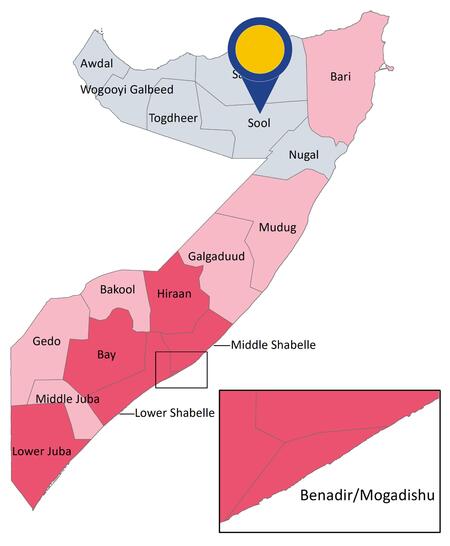COMMON ANALYSIS
Last updated: June 2022
The situation in Sool should be seen in light of the situation in the neighbouring regions of Sanaag and Bari.

General information about the region
Sool region consists of four districts and its capital is Laas Anood.
Sool is inhabited primarily by Dhulbahante, a Darod sub-clan, which is part of the Harti confederation together with the Majerteen clans of Puntland. Isaaq clan has also presence in some parts of Sool region.
In 2014, UNFPA and Somali authorities estimated the population of Sool region at 327 428 inhabitants.
Background and actors involved in armed confrontations
Puntland and Somaliland dispute over political and military control of areas of the Sool and Sanaag regions as well as the area of Ayn, part of Togdheer region. Sool and Sanaag fall within Somaliland’s boundaries, as per the old Anglo-Italian border and protocol and as put forward by the Somaliland government. However, the two dominant clans in the area (Warsangeli and Dhulbahante) belong to the same Darood/Harti clan family for which Puntland constitutes the core and institutional ‘home’.
Sool local authorities have repeatedly switched sides between Puntland and Somaliland in the past, with the latest sources indicating that the Dhulbahante majority is now siding with the Somaliland administration. Somaliland has not managed to expand its areas of control all the way to the boundary between Sool and Nugal regions, which would correspond basically to the ex-British Somaliland border.
The presence of both Somaliland and Puntland armed forces has been reported. Tukaraq, in Sool region, among others, has been the centre of major fighting between the two states in the past few years (2018-2020).
In the context of the Somaliland-Puntland confrontation, fighters were captured and detained by both parties.
Tensions between Puntland and Somaliland in disputed areas reportedly heightened as a result of elections.
In terms of clan rivalries, Sool region is a highly disputed area presenting numerous conflict dynamics. Several inter and intra-clan disputes, involving clan militias, over water wells have been frequently reported. A source has indicated that the real issue is actually linked to clan growth and expansion dynamics. Inter-clan disputes (Isaaq-Darood clan families) have a higher tendency to escalate.
Nature of violence
Inter and intra-clan disputes have led to armed clashes, revenge killings, casualties and displacement. For example, in April 2021 a clash between sub-clan militias resulted in several clan members fatalities. Clan militias have been also responsible for an attack in Las Anood prison leading to clashes with police and two civilian fatalities.
Among others, security incidents related to clan conflicts do not always receive local media attention and hence might go under-reported in Somalia.
An attack on a polling station resulting in at least three fatalities and an IED explosion killing three civilians have also been reported.
Furthermore, clashes between Somaliland and Puntland forces were reported in February 2020, with no fatalities recorded.
Incidents data
ACLED recorded 25 security incidents (an average of 0.3 security incidents per week) in Sool region between 1 January 2020 and 30 June 2021. Out of those incidents, 14 were coded as battles, 2 as explosions/remote violence and 9 as violence against civilians.
Geographical scope
Security incidents occurred in 3 out of 4 districts of Sool region with the largest overall number being recorded in Las Anood district (23 incidents).
Fatalities among civilians and non-civilians
In the reference period, ACLED recorded a total of 27 fatalities in the region. Compared to the figures for the population in the region as from 2014, this represents approximately 8 fatalities per 100 000 inhabitants.
Displacement
Between January 2020 and May 2021, PRMN reported 19 000 new displacements from Sool. Conflict and insecurity led to the displacement of 3 000 cases in 2020 and of 1 000 in 2021. In 2020 and 2021, 1 000 additional displacements to Sool were registered from Togdheer and Sanaag.
Further impact of the armed conflict(s) on the life of civilians
Conflicts between Somaliland and Puntland forces and clan clashes have affected the lives and livelihoods of civilians, as well as access to humanitarian aid. For Sool region, seven incidents of humanitarian workers being unable to access sites were reported in 2020.
In terms of internal mobility and security, Somalis can in general freely move around Puntland without too many security concerns. Exceptions are the contested area in Sool and Sanaag or areas where Al-Shabaab has presence such as around the Galgala Hills.
Harassment against journalists when they reported on government shortcomings or union with Somalia was reported, particularly in the Sool and Sanaag regions.
The number of rape cases increased in Somaliland in 2020, mostly in Sool as well as in two other regions. The surge in violence against women and girls typically manifested itself in two forms: domestic violence against women who have become family breadwinners, and sexual violence against women and girls relocated to camps close to overcrowded urban hubs. Conditions in IDP camps, in Ainabo district, were reportedly disastrous for women’s safety.
|
|
Looking at the indicators, it can be concluded that in the region of Sool there is, in general, no real risk for a civilian to be personally affected within the meaning of Article 15(c) QD. |
